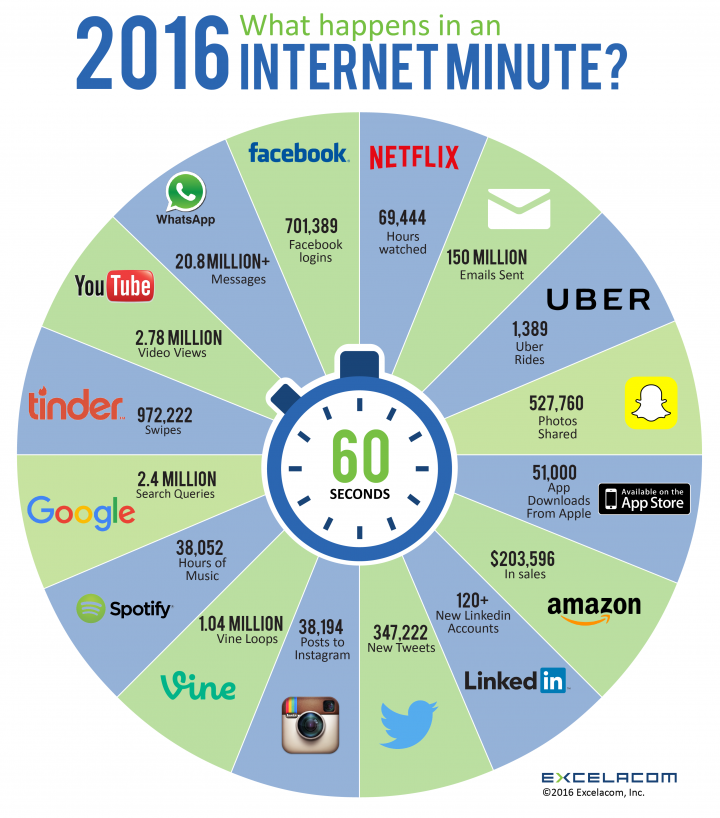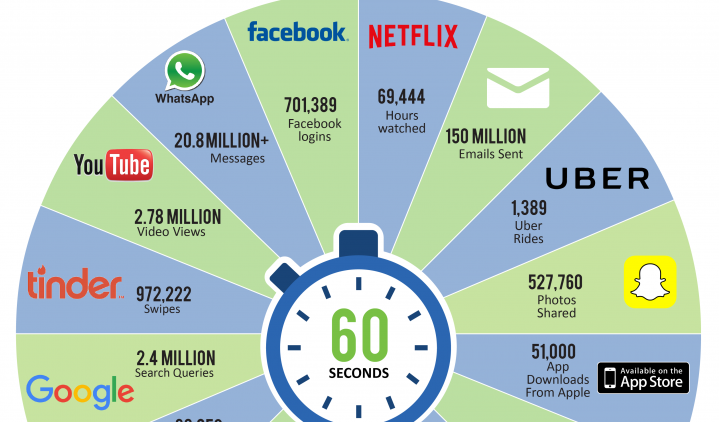Technology
What Happens in an Internet Minute in 2016?
Last week, we published U.S. consumption numbers in real-time, highlighting the speed at which physical goods and services are purchased.
Today, we enter into the digital realm to see what happens every minute on the internet. The statistics are mind-boggling and put in perspective how scalable platforms have taken over the world:

The above infographic shows how truly important the element of scale is to business today.
Google literally processes 2.4 million searches every minute. In that same span of time, 700,000 people login to Facebook and Amazon sells over $200,000 of physical and digital goods.
Platforms such as the ones listed above are comparable in magnitude to other mega-sized companies, but without the intense capital expenditures, debt, or hard costs. That’s why Alphabet, Google’s parent company, can spend over a billion dollars each year on “moonshots”, and why Facebook’s stock is up 35.6% over the last 52 weeks.
Here are the full stats on what happens every internet minute:
- 701,389 logins on Facebook
- 69,444 hours watched on Netflix
- 150 million emails sent
- 1,389 Uber rides
- 527,760 photos shared on Snapchat
- 51,000 app downloads on Apple’s App Store
- $203,596 in sales on Amazon.com
- 120+ new Linkedin accounts
- 347,222 tweets on Twitter
- 28,194 new posts to Instagram
- 38,052 hours of music listened to on Spotify
- 1.04 million vine loops
- 2.4 million search queries on Google
- 972,222 Tinder swipes
- 2.78 million video views on Youtube
- 20.8 million messages on WhatsApp
That’s a lot of data every minute, and this volume of information is part of the reason that these same companies are prioritizing the ability to process and interpret big data more than ever before.
Original graphic by: Excelacom
Technology
All of the Grants Given by the U.S. CHIPS Act
Intel, TSMC, and more have received billions in subsidies from the U.S. CHIPS Act in 2024.

All of the Grants Given by the U.S. CHIPS Act
This was originally posted on our Voronoi app. Download the app for free on iOS or Android and discover incredible data-driven charts from a variety of trusted sources.
This visualization shows which companies are receiving grants from the U.S. CHIPS Act, as of April 25, 2024. The CHIPS Act is a federal statute signed into law by President Joe Biden that authorizes $280 billion in new funding to boost domestic research and manufacturing of semiconductors.
The grant amounts visualized in this graphic are intended to accelerate the production of semiconductor fabrication plants (fabs) across the United States.
Data and Company Highlights
The figures we used to create this graphic were collected from a variety of public news sources. The Semiconductor Industry Association (SIA) also maintains a tracker for CHIPS Act recipients, though at the time of writing it does not have the latest details for Micron.
| Company | Federal Grant Amount | Anticipated Investment From Company |
|---|---|---|
| 🇺🇸 Intel | $8,500,000,000 | $100,000,000,000 |
| 🇹🇼 TSMC | $6,600,000,000 | $65,000,000,000 |
| 🇰🇷 Samsung | $6,400,000,000 | $45,000,000,000 |
| 🇺🇸 Micron | $6,100,000,000 | $50,000,000,000 |
| 🇺🇸 GlobalFoundries | $1,500,000,000 | $12,000,000,000 |
| 🇺🇸 Microchip | $162,000,000 | N/A |
| 🇬🇧 BAE Systems | $35,000,000 | N/A |
BAE Systems was not included in the graphic due to size limitations
Intel’s Massive Plans
Intel is receiving the largest share of the pie, with $8.5 billion in grants (plus an additional $11 billion in government loans). This grant accounts for 22% of the CHIPS Act’s total subsidies for chip production.
From Intel’s side, the company is expected to invest $100 billion to construct new fabs in Arizona and Ohio, while modernizing and/or expanding existing fabs in Oregon and New Mexico. Intel could also claim another $25 billion in credits through the U.S. Treasury Department’s Investment Tax Credit.
TSMC Expands its U.S. Presence
TSMC, the world’s largest semiconductor foundry company, is receiving a hefty $6.6 billion to construct a new chip plant with three fabs in Arizona. The Taiwanese chipmaker is expected to invest $65 billion into the project.
The plant’s first fab will be up and running in the first half of 2025, leveraging 4 nm (nanometer) technology. According to TrendForce, the other fabs will produce chips on more advanced 3 nm and 2 nm processes.
The Latest Grant Goes to Micron
Micron, the only U.S.-based manufacturer of memory chips, is set to receive $6.1 billion in grants to support its plans of investing $50 billion through 2030. This investment will be used to construct new fabs in Idaho and New York.
-

 Education1 week ago
Education1 week agoHow Hard Is It to Get Into an Ivy League School?
-

 Technology2 weeks ago
Technology2 weeks agoRanked: Semiconductor Companies by Industry Revenue Share
-

 Markets2 weeks ago
Markets2 weeks agoRanked: The World’s Top Flight Routes, by Revenue
-

 Demographics2 weeks ago
Demographics2 weeks agoPopulation Projections: The World’s 6 Largest Countries in 2075
-

 Markets2 weeks ago
Markets2 weeks agoThe Top 10 States by Real GDP Growth in 2023
-

 Demographics2 weeks ago
Demographics2 weeks agoThe Smallest Gender Wage Gaps in OECD Countries
-

 Economy2 weeks ago
Economy2 weeks agoWhere U.S. Inflation Hit the Hardest in March 2024
-

 Green2 weeks ago
Green2 weeks agoTop Countries By Forest Growth Since 2001















